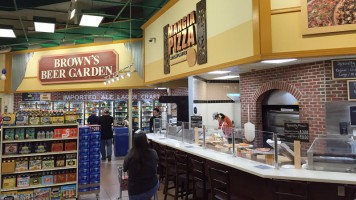
Photo courtesy Brown’s Super Stores, Inc.
It’s amazing where one can find inspiration. In May NPR did a feature on a Southwest Philadelphia grocery store that I immediately tweeted. Then as I read it in more detail I discovered I simply had to write about it. The story concerns opening a grocery store in what was considered to be a “food desert”–an urban area that ostensibly will not support a traditional grocery store with fresh produce and associated “middle class” staples. When Jeff Brown opened his store:
Most people thought he was crazy to even attempt to make money in a food desert like Southwest Philly, he says. Other grocers had tried and quickly gone out of business.
But Brown – a fourth generation grocer whose company, Brown’s Super Stores, is part of the larger ShopRite franchise — tried a different approach: “Before we did anything, we brought together a group of community leaders, and we just asked them to tell us exactly what it is they were looking for in a neighborhood grocery store.” [Emphasis added by this blogger!]
I’ll stop here and let my regular readers compose the rest of this post in their heads. My immediate responses ran along the lines of “Imagine!” “What a concept!” and so forth.
But when I got to the section headed “The Grocery Store as a Gathering Place” I nearly went into orbit.
. . . [H]e added other services and perks, like community centers, which locals sign up to use for meetings and events. Some stores also have credit unions, staff nutritionists, social workers and health clinics. [Again, emphasis added by this overwhelmed blogger.]
Almost all of these services are free, and they are often provided in partnership with local non-profits. “It’s a win-win – because by stationing in our stores, the non-profits get access to more people in need,” he says. “And from our standpoint, each broken social thing hurts business.”
While I am way too old to respond to anything with OMG, OMG! At the risk of articulating the obvious, here we have a successful business created by 1) finding out the needs and interests of the potential customers and 2) being a resource for the community above and beyond the “core business:” community citizenship as good business. Certainly mission creep can be dangerous, but Mr. Brown is adding services that will enhance customer loyalty, draw traffic, and extend the length of time spent in his store.
I was so blown away by all of this I almost missed the closing comment:
“Different things work for different stores. . . . In the end, it’s really about putting the supermarket at the center of the community.”
I’d recommend we all consider the many ways we can put our own organizations at the center of our communities.
Engage!
Doug

[…] Lessons from a Grocery Chain AJBlog: Engaging Matters Published 2015-08-18 Desmond’s Later Years Revisited AJBlog: RiffTides Published 2015-08-19 Snapshot: Dana Andrews sings a song by Aaron Copland and Ira Gershwin AJBlog: About Last Night Published 2015-08-19 [ssba_hide] […]
[WORDPRESS HASHCASH] The comment’s actual post text did not contain your blog url (http://www.artsjournal.com/engage/2015/08/lessons-from-a-grocery-chain) and so is spam.